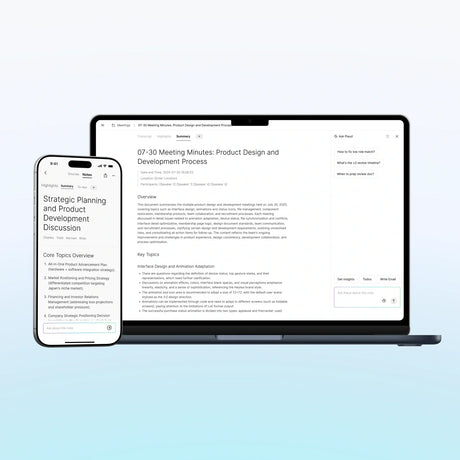Decision-making is a responsibility you can’t escape as a leader. Some calls are minor and may not carry financial, reputational, or legal risks. Others shape budgets, strategy, and even your company’s future. So, how do you make decisions that create real business value?
In this guide, we’ll break down five decision-making models that leaders use in different situations. We’ll also walk through the rational model step by step and show how an intelligence tool like Plaud.ai can make the process smoother.
But first, let’s answer a simple question: What is a decision-making model?
What is a decision-making model?
A decision-making model is a framework that takes you through the process of selecting the most effective course of action. It keeps everyone on your team aligned on the decision by providing these details:
- An overview of the problem
- The decision deadline
- Your reason for choosing a particular solution
- How to measure success
When the stakes are high, you can’t afford to make choices based solely on instincts. A framework forces you to clarify the problem, compare alternatives, and set clear criteria so your decision holds up under pressure. This structured approach reduces second-guessing later because the process is transparent and grounded in evidence.
You’ll get consistency as well. Instead of starting from scratch whenever you are faced with a decision, you follow a structured process. This makes it easier to explain tough calls to teams and clients.
This consistency builds trust, since people can see that decisions are made systematically.
The five main decision-making models
Not every situation calls for the same decision-making approach. A high-stakes financial decision requires more structure compared to choosing a time for the next meeting.
Here are the five main models leaders rely on.

Rational decision-making model
The rational decision-making model uses a methodological approach to find a solution with the best outcome. It involves evaluating alternatives by their pros and cons, which can be time-consuming.
That’s why it may not be viable for everyday calls, like where to grab lunch or what playlist to use during a team break. It comes highly recommended for high-stakes decisions, such as recalling a product line, increasing prices, or acquiring another business.
For instance, when Amazon considered switching from tape backup to cloud storage (Amazon S3), they compared costs, durability, speed, performance, and scalability. This is rational decision-making in action.
Bounded rationality decision-making model
The bounded rationality decision-making framework involves narrowing down solutions to the most realistic options and selecting the one that meets the minimum requirements.
These are the steps to follow:
- Define what “good enough” looks like.
- Scan for options that meet those minimum requirements.
- Stop searching once you find a workable choice.
Bounded rationality decision-making works best when time is of the essence. For instance, if you are losing money every minute due to a system failure, spending hours weighing multiple fixes could cost you even more. In these moments, the ability to make a fast decision can protect resources and buy time for future improvements if needed.
ACA ethical decision-making model
What is the ethical decision-making model? It’s a framework that guides leaders to make choices based on fairness, honesty, and accountability. This means weighing the moral consequences of a decision to avoid reputational damage.
The American Counseling Association (ACA) ethical decision-making model takes you through these steps:
- Understand the problem.
- Apply the ACA Code of Ethics.
- Find alternate lines of action.
- Analyze the consequences of each option.
- Select the most feasible option.
- Execute your chosen solution.
This strategy is valuable in industries that thrive on trust. For example, a hospital will prioritize patient safety over monetary gains even when budgets are tight.
DARE decision-making model
DARE stands for define, assess, respond, and evaluate. So, what is the DARE decision-making model? It’s a tactic that helps you break down problems, act fast, and learn from outcomes.
This model involves these steps:
- Define the problem.
- Assess possible solutions by weighing their pros and cons.
- Respond by executing the most effective solution.
- Evaluate the outcome to see what worked and what needs adjustment.
This approach works well in dynamic settings where you must act quickly but still need structure.
Intuitive decision-making model
The intuitive model involves leaning on your experience, instincts, and creativity to make a choice. Think of a moment when you trusted your gut on a product call—maybe adding a feature no one asked for but you knew could set your brand apart.
The intuitive model may have risks, but it often leads to breakthroughs that structured analysis might miss.
To apply this model, you must:
- Trust your experience to guide the choice.
- Spot patterns that other models might overlook.
- Act quickly when analysis would slow things down.
- Rely on creativity to find solutions.
A practical walkthrough: step-by-step rational decision-making
Making a rational decision involves six steps, from problem definition to outcome evaluation.
Let us take a close look at these steps.

Step 1: Define the problem and the decision owner
Create a one-page decision brief so every major call follows the same structure. You can save time by standardizing the process with a custom template, which keeps these fields consistent:
- Concise problem definition
- Budget, deadlines, and review date
- Measurable goals to aim for
- Alternative solutions
- Risk factors that could affect outcomes
- The person accountable for the final call
- Stakeholders who need to weigh in
- Supporting data (links to reports, research, and notes)
Spelling these out makes it easier to execute a decision and track performance.
Step 2: Identify the criteria for success
Without establishing what success looks like, your team might chase different goals or settle for unclear benchmarks. Success criteria serve as your North Star when you are ready to compare options.
Typical success criteria include:
- Cost-effectiveness
- Alignment with company goals
- Fast implementation
- Sustainability
- Positive impact on stakeholders
Step 3: Weigh the criteria by importance
Not every criterion carries equal weight. For instance, cutting costs might be essential in one situation, while speed could matter more in another. By assigning relative importance to each criterion, you make sure the scoring reflects your team’s real priorities. Scoring can be done with a simple scale or percentages.
Below is an example using a 1–5 scale:
- Cost: 5 (Extremely important)
- Speed: 4 (Very important)
- Quality: 3 (Moderately important)
- Scalability: 2 (Slightly important)
- Ease of implementation: 1 (Least important)
Using percentages, scoring would look like this instead:
- Cost: 40%
- Speed: 25%
- Quality: 20%
- Scalability: 10%
- Ease of implementation: 5%
With percentages, the scores should add up to 100%.
Step 4: Generate viable alternatives (include the status quo)
When brainstorming solutions, include the status quo. The current state is a baseline against which all other solutions will be measured.
For instance, when considering a software upgrade, comparing each alternative to the current system tells you the gains (or hidden costs) of making a change. Without considering the status quo, there is the risk of believing the alternative is automatically better, which is not always the case.
Step 5: Evaluate and score the alternatives using evidence
Measure each option against your weighted criteria. This is where data makes the difference between a confident decision and a risky guess. Good decisions only come from solid data.
During meetings or conversations, key information often gets lost. Plaud Note captures the entire discussion and provides accurate transcripts. This serves as reliable evidence to score your options.

Step 6: Select the best solution, assign owners, and set a review date
After scoring, you already know the best solution. But rational decision-making 619
does not stop there. You need to assign a single owner for implementation and set a review date to check progress against established success criteria.
With Plaud Note’s AutoFlow, you can automatically send the decision summary (final choice, rationale, owners, and dates) via email, Google Docs, or Slack. It also extracts action items from meeting notes and assigns them to the right people. This streamlines your workflow and moves your decision from words to results.
A note on decision-making biases
Even the best frameworks can be derailed by bias. Kodak is a classic example. This tech giant invented the first digital camera in 1975. But because their profits were already tied to film, they treated it as a novelty, choosing the status quo over innovation.
The takeaway isn’t to chase perfection but to build awareness. By testing assumptions against hard evidence, you can make an unbiased choice.
Understanding the different biases
These are the most common biases that affect decision-making:
- Anchoring bias: Sticking to the first option or number you hear
- Confirmation bias: Favoring data that backs your opinion
- Recency bias: Prioritizing the most recent information
- Status quo bias: Sticking with the current state of things
- Similarity bias: Preferring ideas from people who seem similar to you
- Availability bias: Relying on information you can easily remember
- Authority bias: Overvaluing the opinions of someone you perceive as authoritative
- Sunk cost fallacy: Continuing a project you heavily invested in, even if it’s not working
Reduce bias with Plaud Note. This AI note taker offers advanced transcription services, call recordings, and voice memos. Now, you no longer have to rely on memory when evaluating data.
Track key decisions with a work management tool.
Keeping tabs on decisions is just as important as making them. Without a record, teams lose track of what was decided, why it matters, and who’s accountable. A work management tool like Plaud keeps everything transparent.
Here’s what it helps you do:
- Organize all decisions, notes, and action items in one place.
- Share updates instantly across platforms.
- Assign owners and deadlines.
- Create an accessible record to revisit during reviews or audits.
Try Plaud Intelligence today, and save 260+ hours a year with this productivity booster.

FAQ
What is the best decision-making method?
Use the rational decision-making model for big calls, DARE for time-sensitive issues, and intuition when data is missing. Go ethical in a highly regulated industry.
What’s a good deadline for making the decision without rushing it?
Set enough time to gather key information without stalling. Allow typically a week for big choices and a few days for smaller ones.
How do we make a call when data is incomplete or noisy?
Rely on the best available evidence, weigh risks, and use team experience. Plaud’s transcripts help you spot patterns and avoid losing critical insights.






